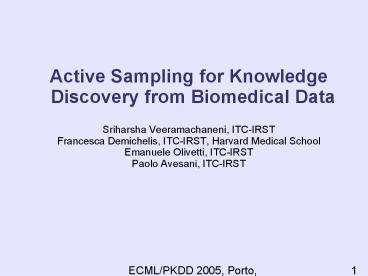Active Sampling for Knowledge Discovery from Biomedical Data - PowerPoint PPT Presentation
1 / 18
Title:
Active Sampling for Knowledge Discovery from Biomedical Data
Description:
clinical features (e.g. status of the patient, relapse) ... TMA block is a paraffin block with 100-1000 tissue cores in array fasion ... – PowerPoint PPT presentation
Number of Views:45
Avg rating:3.0/5.0
Title: Active Sampling for Knowledge Discovery from Biomedical Data
1
- Active Sampling for Knowledge Discovery from
Biomedical Data - Sriharsha Veeramachaneni, ITC-IRST
- Francesca Demichelis, ITC-IRST, Harvard Medical
School - Emanuele Olivetti, ITC-IRST
- Paolo Avesani, ITC-IRST
ECML/PKDD 2005, Porto, Portugal
2
Outline
- Biomarker Evaluation for Cancer Characterization
- Costs Involved
- Formal Definition of Cost-Constrained Biomarker
Evaluation - Outline of Solution
- Experimental Results
- Conclusions
3
Cancer Characterization
- Development of cancer diagnostic/prognostic
models from Data. - clinical features (e.g. status of the patient,
relapse) - histological features (given by the pathologist)
- grade of disease
- tumor dimension
- number of lymphonodes
- ...
- Molecular biomarker features
- protein expression by immunohistochemistry
- gene amplification by fluorescence in situ
hybridization
4
Molecular biomarker features
- Biomarkers are molecular reagents used to test
biological samples, - that add information to the clinical and
pathology data (improve predictive model for
diagnosis/prognosis). - They should impact clinical care.
5
Tissue Micro Array (TMA)
- TMA block is a paraffin block with 100-1000
tissue cores in array fasion - each core is 0.6mm Ø from regions of interest of
the donor block - each TMA block can be sliced in 100-500 thin
slides - each slide tested independently
(immunohistochemistry, florescent hybridization)
6
Donor Blocks
TMA block
TMA Slides
7
Biomarker Evaluation for Clinical Prediction
Process
- Collect biological samples from monitored
patients along with features (clinical,
histological) - Set up an initial dataset. Each record is
- C Clinical information (eg. Dead/Alive, Relapse)
- X Histological features
- Prepare TMA blocks from the biological samples.
- add biomarkers and measure outcomes Y (intensity,
extension) - Analyze the ability of the biomarker Y to predict
C given X. - NOTE This is a one shot process (i.e. one
experiment).
8
Cost Issues
- Limitations in clinical analysis of tissues
- limited availability of tissues
- cumbersome and time consuming procedure
- cost of biochemical reagents
9
Active Sampling for Feature Evaluation
Data set
Choose the most informative (C,X) to sample for Y
No
Sample at (C, X)
Evaluate predictive ability of Y
Budget Exhausted?
Yes
Output estimate of feature utility
10
Active Sampling for Biomarker Evaluation
- collect known features from monitored patients
(clinical, histological) - set up an initial dataset (C clinical , X
histological) - create an initial model to predict C given
already known X - select intelligently TMA block/slide to improve
current model and pay for that information - add biomarkers and measure outcomes (Y)
- build a new model to predict class labels C given
X,Y features. - iterate, going back to (4) until budget exhausted
- Predict error rate of the classifier that uses
both X and Y - NOTE This is an iterative process.
11
Active Sampling Choosing the most informative
sample
- We want to estimate the error-rate (e) of the
classifier using both X and Y accurately. - We should probe where we think sampling will
improve the estimate of the error-rate the most. - We do this by minimizing the expected MSE after
sampling for each (C, X) and choose the lowest. - We show that the above criterion is equivalent to
maximizing the expected difference in the
estimates before and after sampling at (C, X).
12
Active Sampling Issues
- Finding a heuristic to approximate the
theoretically optimal sampling strategy. - Dealing with the bias of the sampling scheme.
- Computational considerations.
13
Experiments Breast Cancer Dataset Description
- 2 alternative class labels (clinical data)
- C1 status of the patient (dead/alive)
- C2 presence/absence of tumor relapse
- 3 known features (histological data)
- X1 tumor type
- X2 pathologist's evaluation of lymphonodes
- X3 pathologist's evaluation of morphology
- 4 biomarkers features
- Y1 nuclei expressing ER
- Y2 nuclei expressing PGR
- Y3 score colour intensity stained area by
P53 - Y4 score colour intensity stained area by
cerbB - Size of dataset 400 record with missing values
(see later) - All features reduced to binary values based on
domain conventions.
14
Experiments Description
- Class Label (C) Known Features (X)
New Feature (Y) Size () - I dead/alive all histological
information PGR 160 - II dead/alive all histological
information P53 164 - III dead/alive all histological
information ER 152 - IV dead/alive all histological
information cerbB 170 - V relapse all histological
information PGR 157 - VI relapse all histological
information P53 161 - VII relapse all histological
information ER 149 - VIII relapse all histological
information cerbB 167 - IX dead/alive PGR, P53, ER
cerbB 196 - X relapse PGR, P53, ER
cerbB 198
15
Some Results
16
Conclusions
- We presented a preliminary solution for
cost-constrained biomarker evaluation - For the same accuracy in the prediction of
feature relevance we need fewer samples. - For the application, this means that we need to
use up less of the valuable biological tissue
resource. - Allows testing more biomarkers on the same amount
of tissue samples.
17
Future Work
- Extend the algorithm to
- Other classifiers
- Continuous features
- Batch active learning, where we sample more than
one sample at a time - Study how much a myopic strategy for sampling is
worse than non-myopic.
18
Thank You

